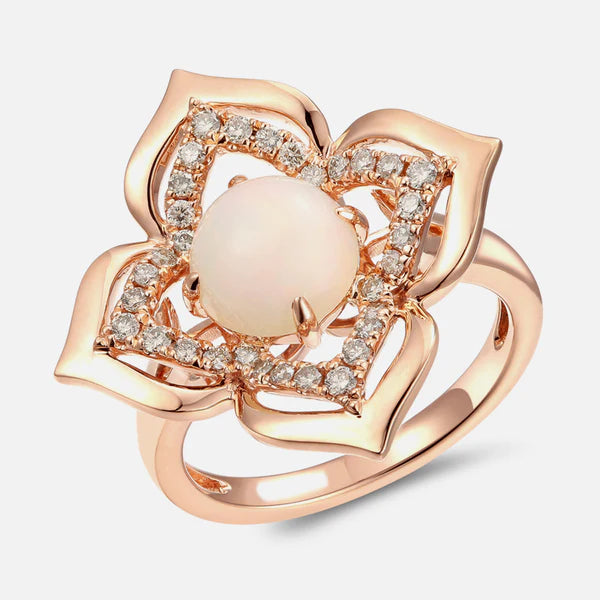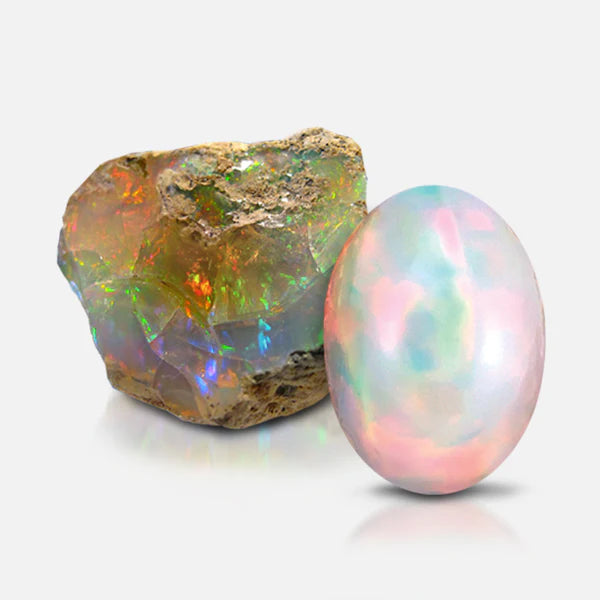Opal

FUN FACTS
Opal was believed to grant its wearer invisibility if wrapped in a bay leaf.
Because opals contain so much water within them, storing them in dry places for extended periods of time can severely damage the stone, a phenomenon known as ‘crazing’.
In the Middle Ages, blond women wore opal in the hopes of keeping their hair color intact.
SELECTION OF JEWELRY
-
LeVian 14K Rose Gold, Oval Opal Cabochon & 2/5 Cttw White/Chocolate Diamond Halo Fashion Ring (H-I & Fancy Brown Color, SI1-SI2 Clarity) S 8
Regular price $1,380.00Regular price -
Le Vian Ring featuring Neopolitan Opal Nude Diamonds set in 14K Yellow Gold
Regular price $1,670.00Regular price -
Le Vian Ring featuring Neopolitan Opal Nude Diamonds set in 14K Yellow Gold
Regular price $1,670.00Regular price -
Le Vian Ring featuring Neopolitan Opal Nude Diamonds set in 14K Yellow Gold
Regular price $1,670.00Regular price -
Le Vian Pendant featuring Neopolitan Opal Chocolate Diamonds, Nude Diamonds set in 14K Rose Gold
Regular price $1,320.00Regular price -
Le Vian Chocolatier Ring featuring Neopolitan Opal Vanilla Diamonds, Chocolate Diamonds set in 14K Rose Gold
Regular price $1,500.00Regular price -
3 cts Multi-Color Opal and Diamond Necklace in 18K Rose Gold by Le Vian
Regular price $2,910.00Regular price -
4 3/4 cts Multi-Color Opal and Diamond Necklace in 18K Rose Gold by Le Vian
Regular price $2,500.00Regular price -
3 cts Red Fire Opals and Diamond Ring in 14K Rose Gold by Le Vian
Regular price $4,140.00Regular price -
Le Vian Grand Sample Sale Pendant featuring Neon Tangerine Fire Opal Chocolate Diamonds , Vanilla Diamonds set in 14K Strawberry Gold
Regular price $1,440.00Regular price -
5/8 cts Multi-Color Opal and Diamond Necklace in 14K Rose Gold by Birthstone
Regular price $420.00Regular price -
1/2 cts Multi-Color Opal and Diamond Necklace in 14K White Gold by Birthstone
Regular price $380.00Regular price -
1 cts Multi-Color Opal and Diamond Necklace in 14K Rose Gold by Birthstone
Regular price $780.00Regular price -
2/3 cts Multi-Color Opal and Diamond Necklace in 14K Rose Gold by Birthstone
Regular price $700.00Regular price -
1/2 cts Multi-Color Opal and Diamond Necklace in 14K Rose Gold by Birthstone
Regular price $640.00Regular price -
1/4 cts Multi-Color Opal and Diamond Necklace in 14K Rose Gold by Birthstone
Regular price $320.00Regular price -
1/4 cts Multi-Color Opal Necklace in 14K Rose Gold by Birthstone
Regular price $300.00Regular price -
1 1/4 cts Multi-Color Opal and Diamond Earrings in 14K Rose Gold by Birthstone
Regular price $1,090.00Regular price -
5/8 cts Multi-Color Opal and Diamond Earrings in 14K Rose Gold by Birthstone
Regular price $310.00Regular price -
1/2 cts Multi-Color Opal and Diamond Earrings in 14K Rose Gold by Birthstone
Regular price $220.00Regular price -
5/8 cts Multi-Color Opal Earrings in 14K Rose Gold by Birthstone
Regular price $220.00Regular price
Find Amazing Jewelry With Opal

Opal
ABOUT
Despite past negative associations, opal has come to symbolize good luck and act as a protector against harm. It is said to aid in productivity and stimulate glands that help control one’s behavior and improving one’s love life and finances. The most well-known opal is precious, which displays what is called ‘play of color’ created by the diffraction of light between silica spheres that lead to brilliant flashes of color. This is in stark contrast to common opal which is normally opaque but comes in a variety of colors including a brilliant orange.

Opal
STORY
The origin of the stone’s name is up for debate. While many assume that it’s derived from the Sanskrit‘Upala’, others opine its origins in the name of the Roman Ops, the goddess of fertility. In antiquity, the rare stone was cherished because of its unique, rainbow-like appearance (second only to rubies) and has been included in the crown jewels of many European countries. In the 1800s, Sir Walter Scott’s novelAnne of Geiersteinturned the stone’s reputation from one of good luck to something wholly negative after killing off one of his characters who possessed an opal talisman, causing sales to crash and remain stagnant for 50 years. Until the 19th century revealed another source in Australia (now making up nearly 97% of the world’s supply) the only known place the opal could be found was in Cerevenica in modern day Slovakia.
GEMOLOGICAL SPECIFICATIONS
-
FAMILY
Opal Species
-
CHEMISTRY
SiO2·nH2O
-
REFRACTIVE INDEX
1.37 - 1.52
-
BIREFRINGENCE
0
-
SPECIFIC GRAVITY
1.98 - 2.50
-
HARDNESS
5.5-6.5























